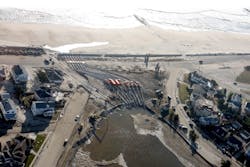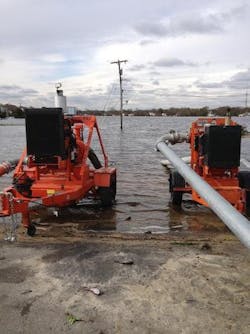About the author:
Mike Sturgill is regional sales manager for Xylem Inc.
As severe weather events increase in frequency and intensity due to climate change, community leaders are grappling with the need to bolster the resilience of public infrastructure to ensure the safety of their communities while facing budget constraints and competing priorities (i.e., COVID-19 relief efforts). With record-breaking hurricanes hitting the United States, it’s more important than ever that businesses and municipalities are ready for extreme weather. Resiliency best practices and contingency planning can help to mitigate the risks and damage associated with severe weather.
Storms are on the rise. In fact, about two-thirds of the U.S. is experiencing much greater than average rainfall per event now than just 20 years ago. The Northeast, for example, now receives 71% more rainfall per event than a few decades ago, according to the U.S. Global Change Research Program. And lightning strikes are increasing, too. Every 1°C increase in global temperature causes 12% more strikes, which lead to SSOs through direct hits to pumping stations, or widespread power outages.
The consensus among scientists is that the effects of climate change, such as rising sea levels and warmer oceans, have made these storms far more destructive than they would have been in previous decades. The devastating impacts are powerful reminders that the effects of climate change cannot be ignored. It’s important for municipalities and businesses to act now to adapt to these changing weather patterns by building more resilience into critical networks.
Addressing Aging Infrastructure
According to the American Society of Civil Engineers’ (ASCE) Infrastructure Report Card, more than 40% of U.S. water infrastructure is rated poor, very poor or past its useful life. The nation’s more than 800 combined sewer systems are at greatest risk from intensifying extreme weather events with more than 50,000 age-related system breaks occurring each year.
The U.S. Environmental Protection Agency (EPA) estimates that at least 75,000 sanitary sewer overflows (SSOs) occur every year, and widespread weather events often trigger SSOs in multiple communities simultaneously. These overflows discharge nearly 900 billion gallons of sewage into lakes, rivers, streams and other water sources, posing serious health risks to people and wildlife, as well as the possibility of lawsuits and punitive actions.
Preventing SSOs requires constant vigilance — routine cleaning and maintenance to remove unwanted materials and uncover problem areas — as well as investments of time and resources in new equipment, including backup systems. Unfortunately, there is no way for municipalities to completely protect against SSOs; even the best-maintained sewer systems still spill at the rate of five SSOs per 100 miles.
The best plan of action is for communities to understand the causes of SSOs and to be aware of risks in their specific area in order to prepare for the worst. By taking proactive steps in advance of disaster events, and by responding quickly and methodically in the aftermath of these disasters, communities can save lives, time and money. Rapid dewatering, diligent emergency services, and innovative reconstruction efforts contribute to the efficient restoration of cities to their pre-disaster status — and even allow them to come back stronger.
Preparing for Extreme Weather Events
Proactive preparedness is essential to combating high tides, flooding and structural damage in major municipalities and affected areas. One of the most important things community leaders can do to prepare for an extreme weather event is to develop a contingency plan — a rapid-response action plan that can be activated quickly in the event of an extreme weather event to minimize damage and downtime. The plan contains critical information about flood risk areas, as well as the equipment needed when severe weather hits.
When developing a contingency plan, it is important to consult professionals to ensure a robust strategy. Getting expert advice from qualified professionals ensures that communities and businesses identify the right strategies, rental equipment and resources to keep their operations up and running. Smart planning before disaster strikes saves time, money and even lives.
An effective contingency plan should include:
- Customer operations;
- Identifying potential issue areas in the flood-prone network;
- Technology and equipment required to tackle flooding when it occurs;
- Measures required to mitigate damage;
- A list of emergency response equipment needed during a catastrophic event, including pumps, hoses and piping, generators, light towers and other support equipment;
- 24/7 emergency contact information for qualified and responsive experts; and
- Directions to emergency bypass locations so emergency responders can act as quickly as possible.
Without a contingency plan in place when a storm hits, there is a greater risk of having to wait longer than necessary for dewatering and bypass equipment to arrive before starting to mitigate damage. During a hurricane, it’s likely that other neighboring communities will also be affected — causing a potential shortage of locally available equipment.
A contingency plan makes sense for all types of emergencies, not just natural disasters. With mechanical equipment it is a matter of when it will fail, not if, and when this happens it is important to have a “plan B” on hand.
Permanent Backup Pump Solutions
In recent years, Xylem has increasingly worked with customers to develop contingency plans that allow for the permanent installation of backup pumps and associated equipment to protect critical infrastructure. In particularly severe weather-prone areas like Florida, Godwin Dri-Prime Backup (DBS) systems have been permanently installed in numerous lift stations to provide backup pumping so that the lift station can continue to operate during power outages.
Effective contingency planning will mitigate the effects of SSOs in emergency situations, but including dewatering pumps within the risk reduction plan can also provide additional peace of mind. A permanently installed engine-driven pump that operates as a backup system to relieve the primary system in the event of station failure is one of the ultimate advancements to support disaster response. Backup pumping systems provide 100% redundancy while also providing additional capacity to handle wet weather flows and pressures, reducing the possibility of SSOs and minimizing the risk of contamination to the surrounding environment as a result.
Xylem’s Godwin DBS is a backup pump that runs on diesel or natural gas and can be permanently installed in a pump station to protect against electrical or mechanical failures of any kind. Plumbing directly into the wet well, the Godwin DBS automatically protects against loss of power, transfer switch malfunction, control panel malfunction, transducer and permanent pump failures.
Communities are also leveraging monitoring and controls systems to help prevent from flooding and related storm damage. Real-time monitoring solutions offer early warning and critical data needed before and during storm and flood events to help utilities stay ahead of dangerously high flows.
Weathering the Storm
Effective contingency planning helps to ensure that communities can access the dewatering equipment they need, when they need it, to minimize emergency response time and accelerate recovery. But even with precision planning, severe weather events remain unpredictable.
Every moment counts when it comes to effectively mitigating the impact of severe weather events and building a community’s resilience. When hurricanes and major storms cause flooding, Xylem has the capability to respond at any hour with portable pumping equipment that operates independent of the electric power grid to remove floodwaters from critical infrastructure areas or to keep municipalities’ water infrastructure operational.

